Turtles make amazing pets, but one of the most important things to remember is that not all turtles grow to be the same size. This may not be an important factor for some people, but if you live in a tiny apartment or can’t afford to purchase a large aquarium, it is important to know which turtles stay small.
In this article, we will take a look at some of the factors you should consider when choosing a turtle as a pet. We will then go over 15 small turtles that make great pets for those who are prepared to care for them properly.
15 Turtles That Stay Small – Find The Perfect Pet
Now that you know all there is to know about turtles and their habitats, you should be able to decide if a pet turtle is right for you and your lifestyle. If you’ve decided to dive head-first into the world of turtle-keeping, here are some of the smallest turtle species you can find! Not only do they make great pets, they’re also irresistibly cute!
1. Red Eared Slider Turtle

- Scientific Name: Trachemys scripta elegans
- Origin: North America
- Average Length: 6 – 8 inches
As one of the most popular beginner turtles in the hobby, red-eared sliders are native to the southeast United States. They are known for the bright red markings on their necks, which earned them their common name. This species has been introduced to several other parts of the world, where it commonly breeds with local freshwater turtle populations to produce hybrids.
These turtles are omnivorous, meaning they’ll eat pretty much anything they can fit in their mouths. They are known for being highly adaptable when it comes to diet, which is why they make such good pets. As long as their turtle pellets contain plenty of protein and calcium, they will be perfectly healthy. The best part? You can house up to three red-eared sliders together in a regular aquarium!
2. Spotted Turtles
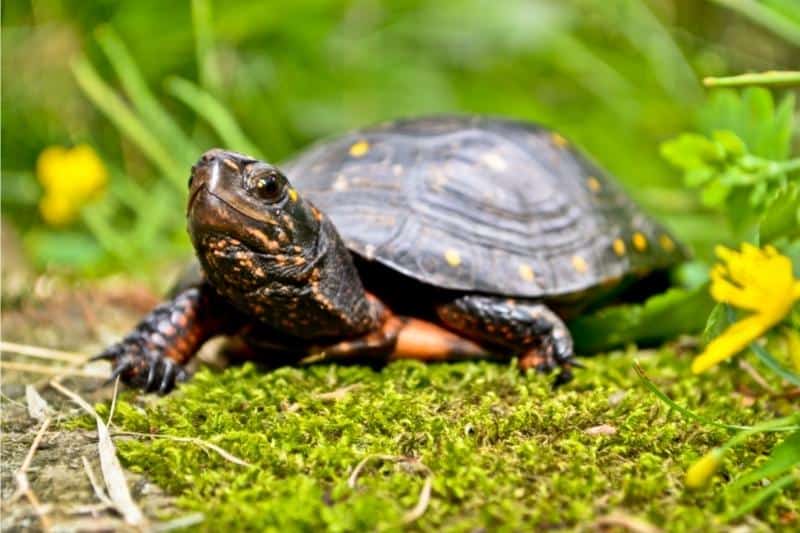
- Scientific Name: Clemmys guttata
- Origin: South East USA
- Average Length: 4 Inches
With an average length of approximately 4 inches, spotted turtles are popular starter pets due to their small size. These small-sized turtles have a natural camouflaging coloration that will help them blend in with the bottom of your tank. The striking black spots on their heads, necks, and limbs are another reason why these turtles are so easy to recognize.
Spotted turtles are semi-aquatic, meaning they spend most of their time on dry land but will take to the water occasionally. They are omnivorous, so they’ll eat both plant matter and animal protein. Their diet should consist primarily of turtle pellets mixed with insects or worms at least once per week.
3. Mud Turtles
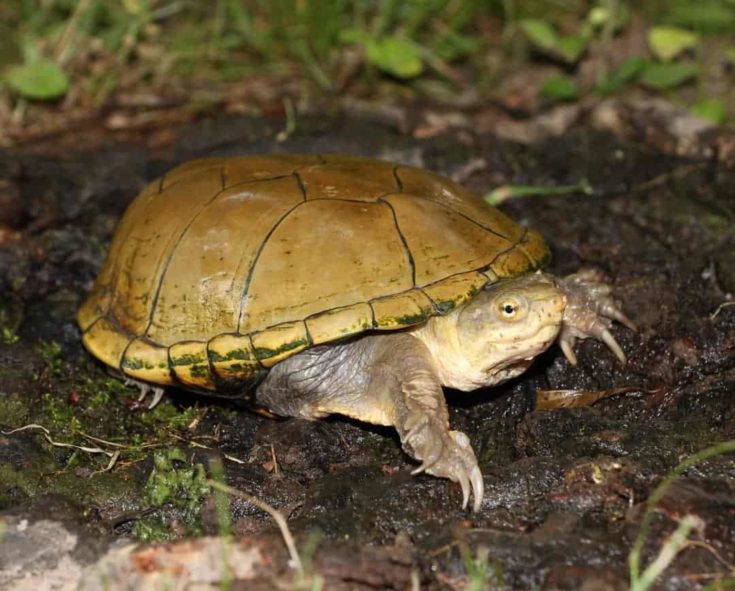
- Scientific Name: Kinosternon subrubrum
- Origin: South East USA, Mexico, and North America
- Average Length: 4 – 6 inches
Mud turtles are yet another species of turtle that’s native to the southeastern United States. They are usually brown or black in color, with a symmetrical shell that is round and slightly domed. Mud turtles can be found at nearly any body of water where there’s fresh vegetation for them to feed on.
Personality-wise, mud turtles are fairly laid back. They tend to be shy when they’re in an aquarium, which is why they need a spacious tank that features lots of hiding places. These turtles are omnivorous, so their diet should consist of both plant matter and animal proteins in order to be healthy.
4. Musk Turtle
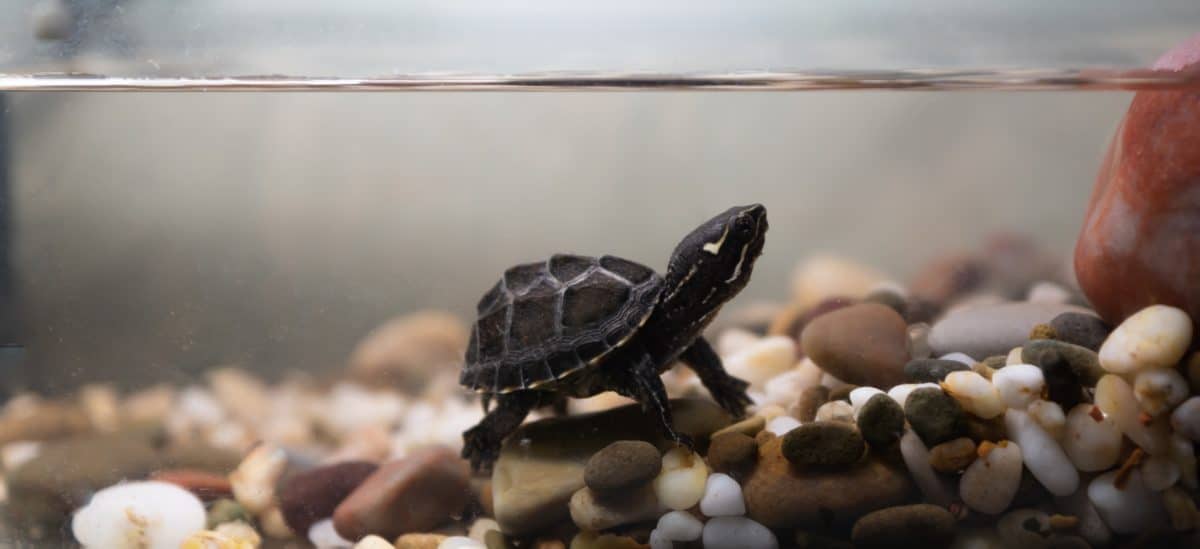
- Scientific Name: Sternotherus odoratus
- Origin: Northeast USA, Southeast Canada, and North America Average
- Length: 4 – 5 inches
Sometimes known as “stinkpots,” musk turtles get their name from the foul smell they release when they’re taken out of water. This smell is a defense mechanism that keeps predators away. These turtles are part of the mud turtle family, but unlike their relatives, musk turtles have oval shells with a green coloration.
Though this is a fairly common turtle, these animals have a number of interesting features that make them intriguing to watch. Their bodies feature a keel-shaped belly and sharp claws on their front appendages, while their tails have a single spine with a tiny red fin attached to it. Musk turtles are also known for their distinct downward-facing mouths, which makes them look like they’re continuously frowning!
5. Reeve’s Turtle

- Scientific Name: Chinemys reevesii
- Origin: Eastern Asia Average
- Length: 4 – 6 inches
Reeve’s turtles are native to China, Japan, and Korea, but they’ve also been introduced to northern Australia after being bred in captivity. Unlike other species of turtle that live on land, these ones spend most of their time in the water. They’re typically black with yellow or orange markings that extend from their eyes down to their necks.
These turtles are carnivorous. They’ll eat aquatic animals like fish, insects, and even small frogs. Hatchlings will eat smaller prey like worms or tiny insects, but their staple foods should consist of turtle pellets mixed with fresh meat. Their diet should never be one-sided!
6. Bog Turtle
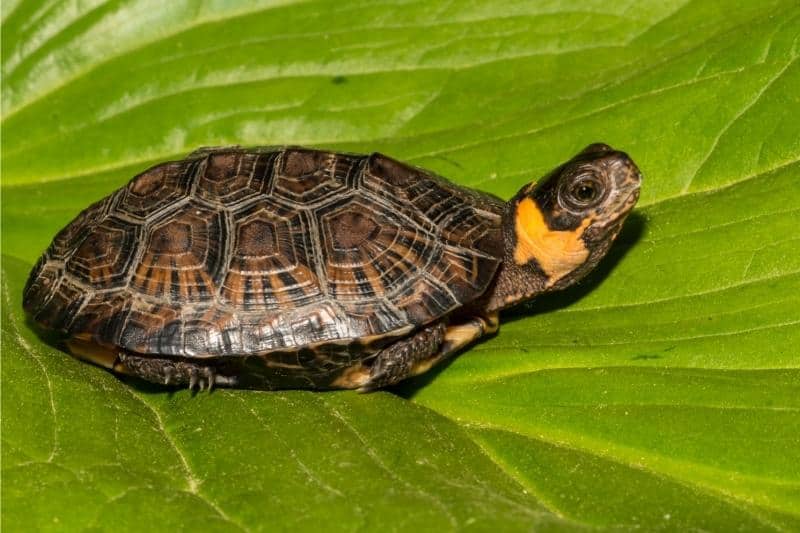
- Scientific Name: Glyptemys muhlenbergii
- Origin: Eastern USA and Southeastern Canada
- Average Length: 3 – 4 inches
There are two subspecies of bog turtles that can be found in the United States: Glyptemys muhlenbergii and Glyptemys insculpta. Both subspecies have domed shells, but those belonging to G. muhlenbergii typically have patterns that appear as if they’re burnt into their shells.
Unlike other species of turtle, bog turtles are known for their intricately patterned shells. Their bodies are gray or brown in color, with dark spots on their head and necks. Even though these turtles lay eggs in nests that they’ve dug in the dirt, they’re not considered to be “land” turtles because they only leave their nests by accident or when the temperature outside is warm.
7. The Desert Box

- Scientific Name: Terrapene ornata luteola
- Origin: Southwestern USA
- Average Length: 3 – 4 inches
Box turtles are part of the aquatic turtle family, but they’re more closely related to tortoises than other members of this group. Desert box turtles are the smallest subspecies of box turtles, and they’re the only ones that live west of Texas.
The shells and undersides of these turtles feature a greenish-yellow color, and their feet and necks are yellow as well. Their heads have colored markings that range from bright orange or red to brown or gray. These turtles love to eat juicy fruits like strawberries and grapes, but insects are what they typically prefer.
8. Florida Softshell Turtle

- Scientific Name: Apalone ferox
- Origin: Southeastern USA and Northeastern Mexico
- Average Length: 8 Inches
Florida softshell turtles have long necks and flattened shells that are typically brown or olive green in color. Younger ones will have yellow stripes on their necks, but those markings disappear as they age.
These turtles spend most of their time in the water, but they also love to bask under the sun every now and then. When it’s feeding time, they’ll eat plants, fish, insects, frogs, and other small animals.
9. Diamondback Terrapins
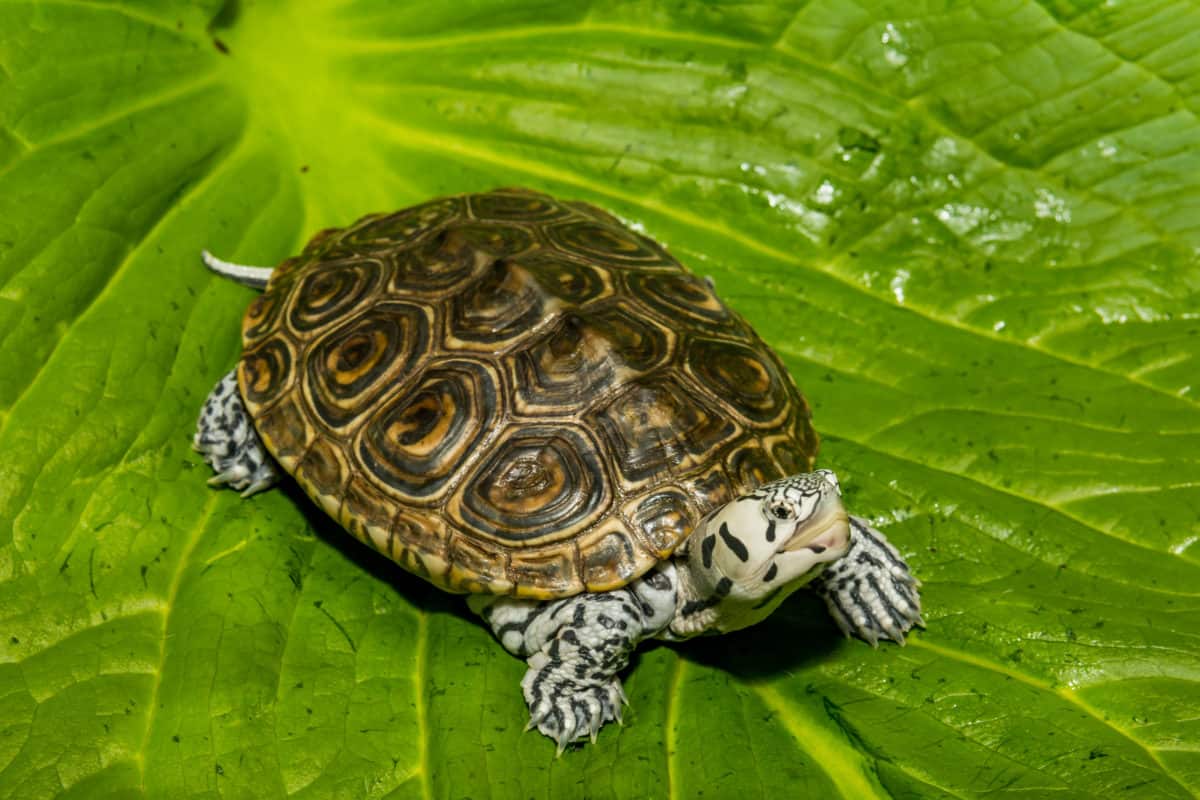
- Scientific Name: Malaclemys terrapin
- Origin: Southeastern USA and Northeastern Mexico
- Average Length: 4 Inches
When people think of turtles, diamondback terrapins are often the first ones that come to mind. These turtles are considered semi-aquatic because they spend most of their time in saltwater marshes, swamps, and brackish waters.
Covered with a green or brown shell, they have five toes on each front leg and four on the back legs. Their necks and tails are typically longer than those found in other terrapin species, and their undersides are lighter in color. Diamondback terrapins get their names from the diamond patterns that appear on both sides of their shells.
10. Razorback Musk Turtle

- Scientific Name: Sternotherus carinatus
- Origin: Southeastern USA and Northeastern Mexico
- Average Length: 4 Inches
Razorback Musks are known to be a little bit feisty, and they’ll spend most of their time in the water. They don’t come out much when it’s cold, but when summer comes around, they like to bask in the sun and swim around in shallow waters.
With a light brown or black shell and smooth skin that’s typically dark green in color, these turtles have very interesting necks; the top of their heads are darker, and their necks have a spectacular yellow stripe that runs across them. They’re known for having some of the largest eyes in comparison to other turtle species.
11. African Sideneck Turtle
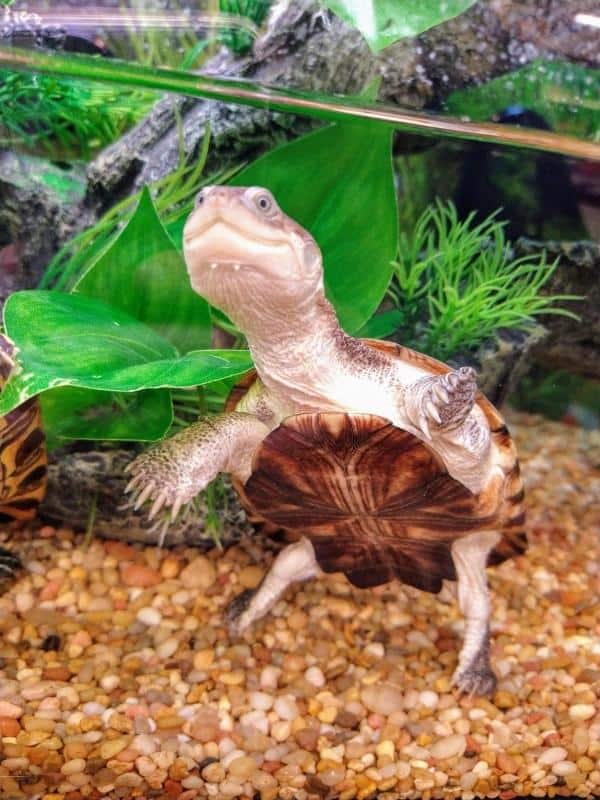
- Scientific Name: Pelusios castaneus
- Origin: Africa
- Average Length: 6 Inches
Named for their neck and tail shape, African sideneck turtles come in a variety of brownish and grayish colors. Some of them have yellow markings on their neck, neck groove, and underbellies. Others will look like they’ve been covered in mud because of the dark coloring of their shell and skin.
Their necks allow these turtles to grab their prey and pull it into their mouths, making it easier to swallow. They’ll eat a lot of different types of food, from crayfish and crabs to mollusks and earthworms.
12. Yellow-Bellied Slider
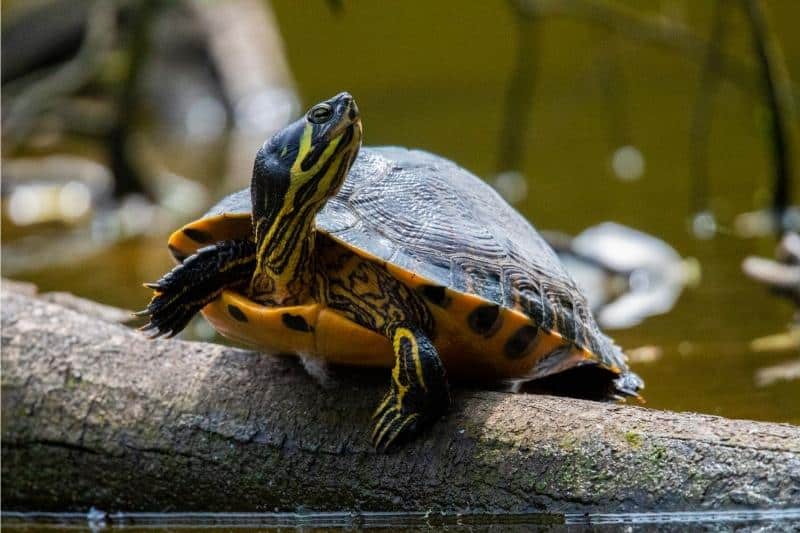
- Scientific Name: Trachemys scripta scripta
- Origin: Southeastern USA to Northeastern Mexico
- Average Length: 8 Inches
Yellow-bellied sliders, which are one of the most common types of pet turtles, can grow to be up to eight inches long. They typically have olive or brown shells with yellow stripes that run down their necks and tails.
Their scales are dark-colored on their backs and light in color on their stomachs, making them easy to camouflage when they get into the water. They’re known to be territorial and will fight with each other, so it’s best to keep just one of them in a tank. This will keep every turtle happy and healthy.
13. Map Turtle

- Scientific Name: Graptemys geographica
- Origin: Eastern USA and Northeastern Mexico
- Average Length: 4 – 6 inches
Strangely, map turtles have been known to travel long distances from their homes in order to find new places to live. That means if a turtle is taken from its natural habitat and placed into an aquarium, it could eventually escape and survive outside of the tank.
Since they’re so small, this is hardly a problem for pet owners. Map turtles are easily identified by their brown or black shells, which have red or yellow stripes across them. They have small heads in comparison to the rest of their bodies and large eyes that make it easy for them to find food.
14. Wood Turtle

- Scientific Name: Glyptemys insculpta
- Origin: Eastern USA and Northeastern Mexico
- Average Length: 4 – 6 inches
One of the most interesting things about wood turtles is that they sometimes prefer to live in water. That means it’s best to put a bowl of fresh, clean water in their tank and let them decide whether or not they want to go for a swim.
They’re also very social and like to spend time with other turtles, so it’s best to keep more than one of them in an enclosure. Their shells are typically grayish brown, and their skin is yellow or green. The color of their eyes can range from bright yellow to blue, although they’re usually dark with noticeable pupils.
15. Western Painted Turtle
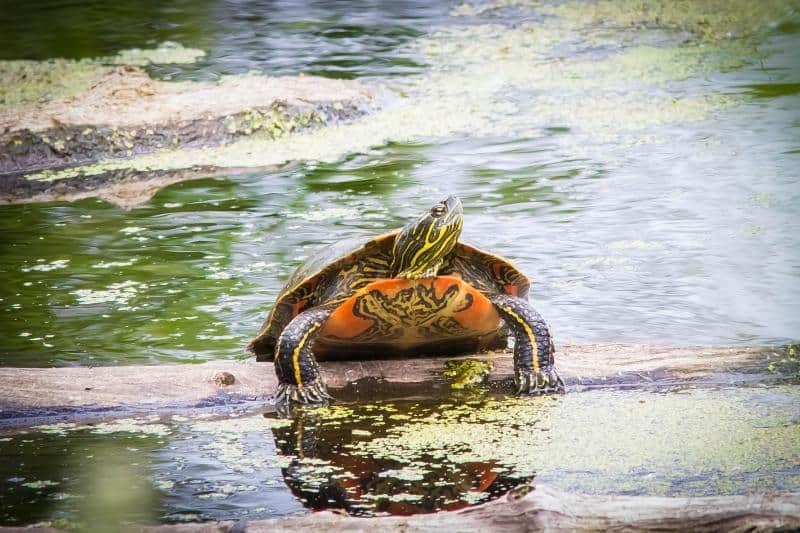
- Scientific Name: Chrysemys picta belli and C. p. dorsalis
- Origin: Western USA and Northwestern Mexico
- Average Length: 7 – 9 inches
The shell of a western painted turtle can be red and yellow and has black and white designs on it. There’s also blue coloring around their eyes and underbellies, which some people might mistake for dirt.
These turtles are very active, so they’ll need plenty of space to move around in an aquarium. They’re known to get aggressive, so it’s best to keep just one of them. If you want a painted turtle as a pet, be sure to check local laws before purchasing one because they’re illegal in some areas.
Is A Pet Turtle Right For Me?
Before we jump into the list, let’s talk about some of the factors you should consider before deciding to get a turtle as a pet. These are important issues that will help you determine whether or not a turtle is right for you and your family.
Food Costs

One of the key things to remember about owning a turtle is that they are not cheap to feed. Turtles can be quite voracious eaters, and will sometimes eat food faster than you can put it in the tank. The bigger the turtle, the more food it needs throughout its life. This means that turtles can get very big, very quickly, resulting in increased food costs.
Therefore, if budget is a concern, you should make sure that you can afford to feed the turtle you want to buy for at least its first year of life. Some larger turtles eat as much as $500 in commercial food alone their first year!
Housing Costs
Turtles need a proper environment with plenty of room to swim around. If you plan on getting more than one turtle, the costs can skyrocket. If you’re just looking for one turtle, investing in an aquarium that is at least 55 gallons is generally recommended.
You should also be prepared for the additional cost of maintaining the tank itself. Maintenance costs include proper cleaning and water changes, and spending at least $100 on a high-quality aquarium filter. All of these factors can add up quickly if you’re not prepared for them, so make sure that you are ready to invest in your turtle’s habitat before bringing one home.
Ease of Care

Every pet animal requires some level of care, but turtles are particularly demanding. Adult turtles need proper care in the form of food, water, and tank maintenance. Tedious as it may be, tank maintenance is of utmost importance because water with lots of waste can spread disease among your turtles.
When selecting a pet turtle for your home, opt for one that fits into your lifestyle. If you have lots of time and resources on your hand, the sky’s the limit! Otherwise, you will need to opt for something that’s relatively low-maintenance.
Experience Level
Of course, whether or not a turtle is right for you also depends on your experience level. If you have never owned a turtle before, then it is often best to start with smaller, common pet turtles that are known to be easier to care for. This way, you can get an idea of what turtles are like and whether or not they will work well in your family.
Make sure that if you do decide to get a turtle, you do plenty of research in order to be well-prepared for the experience. If you’re still interested in getting one even after learning about their needs, then by all means go for it!
Where To Buy Your Miniature Turtle
If you’ve decided that you want a turtle, it’s time for the next step: where to get one. Popular pet turtles are available in many different places, such as pet shops that specialize in fish and small animals, reptile specialty shops, captive breeders, and even on websites like eBay. Though you can find attractive turtles through each of these sources, this type of pet is best purchased through a turtle commercial breeder.
A turtle breeder is someone who breeds turtles in order to sell them. Usually, these are turtle lovers who have more of a connection with the animals than other sources, meaning that they are more likely to have healthier turtles and a more extensive variety of pet turtle species. Whether you’re looking for an ornate box turtle or a common mud turtle, a breeder is guaranteed to have what you want.
Most importantly, buying from an ethical breeder ensures that you only house captive-bred turtles in your home. This is important because wild turtles may not be able to adapt well to life in captivity. Therefore, to ensure that you have a happy turtle, it’s best to buy one that was born and raised in captivity.
What Kind Of Habitat & Enclosure Does A Turtle Need?
After you’ve chosen a turtle and purchased it, the next step is setting up its habitat. It’s important to keep in mind that different turtle breeds need different enclosures that most closely replicate their natural habitat, but there are some general rules that apply to most turtles when it comes to housing. Here are some factors to keep in mind when looking for a turtle habitat.
Clean Water
Whether your turtle thrives in freshwater or brackish water, it’s important to always make sure that the water is clean and matches their needs. This means providing adequate water filtration and testing the water regularly to ensure that it doesn’t have too much chlorine or other chemicals, as well as making sure to change out part of the water once a week.
Most popular turtles thrive in slow-moving water, which encourages them to swim. However, stagnant water is extremely dangerous because it can breed bacteria and other parasites, which can, in turn, lead to fungal infections and other diseases. You should never keep your water dirty for this very reason, so please make sure to change it out regularly.
Adequate Tank Size
Turtles may have a reputation for being low-maintenance pets, but even the smallest species will need a tank that is at least 20 gallons in size with water levels that are about twice as deep as the turtle is long. This means that if your turtle is 5 inches long, you will need water that is at least 10 inches deep.

Another rule of thumb when it comes to selecting the correct size tank for your pet turtle is to allocate at least 10 gallons of water per inch of shell length. This may come as a surprise to some pet owners because individuals in the pet trade sometimes house their turtles in tiny tanks. Unfortunately, this is highly irresponsible and can lead to a variety of health problems, including dehydration and even heart disease.
Therefore, it is safe to assume that you will need to invest in larger aquariums that can accommodate lots of water if you want to house turtles. For every additional turtle that you house, you will need to increase the size of the tank and all of its accessories. If you think that you might be interested in keeping more than one turtle, then please make sure that you start out with a large tank with deep water from the very beginning.
Sufficient Warmth
Turtles are cold-blooded animals, so they require warmth to regulate their body temperature. There are several reasons why you have to ensure that your turtle’s habitat is warm, but the most important factor is that turtles need this type of warmth in order to digest their food properly.
To maintain a proper water temperature, you have to invest in a good heater. Fortunately, there are lots of options on the market that are specifically designed for turtle tanks. In addition, turtles living in an outdoor enclosure will require a light source to regulate their body temperature, just like turtles living in an indoor tank.
One of the most popular choices is a ceramic heater that you have to place underwater and then plug into a nearby electrical outlet. Make sure that you let your new turtle adjust to the tank before using the heater so it doesn’t get burned.
Basking Spots

Though aquatic turtles typically come to mind when you think about the species as a whole, the vast majority of turtles kept as pets are considered semi-aquatic species. Unlike aquatic animals, most pet turtles will need to spend some time on land or in a dry environment. Enter the basking spot.
In the wild, basking is a way for turtles to get warmth from the sun’s rays while they’re on land. This may be a small rock or some kind of structure that is designed to provide a dry space out of the water. Turtles raised in captivity will also need a place to bask, which is typically a terracotta platform that can be placed at the edge of the turtle tank.
To maintain an ideal basking spot temperature, you will need to use a heat lamp or heat light, which you can place over the basking spot. This will help turtles to regulate their body temperature, which is crucial for healthy growth and development.
UVB Lighting
Having just covered heat lamps, you might be wondering why a UVB lamp is necessary for a turtle’s basking spot, especially when you consider how bright it already is in the tank. Well, this is because natural sunlight contains ultraviolet B (UVB) rays that are prevented from entering most turtle tanks via glass panes or other barriers.
The thing is, UVB is crucial for the synthesis of vitamin D3 in turtles and most other reptiles. Without it, they won’t be able to process calcium properly, which can lead to all sorts of health issues down the line.
Fortunately, there are now UVB lamps specifically designed for any type of turtle, from neonates to adults. They are typically narrow and placed over the basking spot, which helps your turtle get plenty of exposure without getting burned.
Aquatic Plants
While it’s true that turtles don’t require plant materials in their tanks, there are actually several reasons why you should include some in your turtle’s aquatic environment. The first reason is that they will help to detoxify the water, so if your tank starts to smell bad, add a few live plants, and this problem should resolve itself within a few weeks.
Next, turtles love to eat live plants and even dig through the soil, so they can use them as a source of food if their diet is deficient in certain nutrients. Finally, some turtle species actually need aquatic vegetation in order to graze on and digest their food properly. Hobbyists can choose from a wide variety of plants that are suitable for turtle tanks, such as highly popular water lettuce.
A Balanced Diet
Last but not least, the most important component of your pet turtle’s habitat is access to a variety of foods that are rich in protein, calcium, and vitamins. Different types of turtles will prefer different types of foods. For example, musk turtles survive on a carnivorous diet composed of fish, insects, and worms in the wild, so you’ll need to feed them a varied diet of animal blends.
If your turtle is a herbivore or omnivore (as most are), then you can feed it a combination of high-quality animal foods and leafy vegetables. Examples of leafy greens that turtles enjoy include:
- Turnip greens
- Mustard greens
- Collard greens
- Romaine lettuce
In addition to green vegetables and animal products, commercial turtle diets are also available. Commercial turtle food and aquatic turtle pellets are typically formulated to contain the optimal nutritional content for healthy growth and development in all types of turtles, so if you’ve been finding it difficult to come up with a balanced diet for your turtle, consider switching to aquatic turtle food!
Parting Thoughts
We hope you enjoyed our list of 15 turtles that stay small! If you want to learn more about turtles as pets, please check out our other articles on caring for pet turtles, and if you have any questions, please leave a comment in the comments section below!
